This is one of the most embarrassing episodes in the history of Podhale. In the fall of 1939, a delegation of highlanders paid tribute to Hans Frank. Several influential families were behind the collaboration with the Nazis. Shortly after the outbreak of the war, they began to widely propagate the idea of a "highlander nation" allegedly related to the "Aryan race". Goralenvolk was to give them protection, honors and money from German masters.
It is November 7, 1939. The day before, the Gestapo, as part of Sonderaktion Krakau, arrested professors and lecturers of the Jagiellonian University and the Mining Academy. A delegation from Nowy Targ shows up at Wawel, where the General Governor, Hans Frank, now resides.
The group of highlanders dressed in characteristic folk costumes includes Wacław Krzeptowski, Karolina Gąsienica-Rój, Maria Siuta-Szwab, Stefan Krzeptowski and Józef Cukier. The visit takes place in a warm, courteous atmosphere. The highlanders present the governor with the Golden Ciupaga - a symbol of cooperation with the German nation.
Frank accepts the gift, and the reptilian press widely writes about the alliance between the highlanders and the occupant causing outrage in society. Later the visit of Podhale people to Wawel was contemptuously called the "homage to Krakow".
The Germans liked the declaration of an alliance with the highlanders very much. So much so that Hans Frank returned to Zakopane five days later. It was there that Wacław Krzeptowski, an influential leader and leader of a group advocating an alliance with the occupant, publicly thanked him for "liberating the Highlanders from the oppression of the Polish authorities" and presented him with a commemorative highlander badge.
Susceptible soil
The Germans, who pursued a policy of extermination as well as a Kultkampf, seeking the possibility of dividing Poles to such an extent that they would lose their national consciousness, were particularly concerned. Any secessionist movements that emphasized more or less actual separateness were on their behalf. Wojciech Szatkowski, author of the book "Goralenvolk. A story of betrayal ”and grandson of one of the leaders of Goralenvolk writes:
The Germans from the beginning led the action of Goralenvolk according to the old and proven Roman principle:divide and rule. As a result of this deliberate policy, the Polish nation was to be divided into die Goralen - Górali, die Kaschuben - Kaszubów, die Masuren - Mazurów, die Schlonsaken - Silesians and other nations.
Such a division would make it easier for the Nazis to subdue and finally destroy and completely Germanize the Polish nation in accordance with the secret directives of Heinrich Himmler. Therefore, in October 1939, the Germans started with such energy to create a previously unknown Goralenvolk. They had the ground prepared.
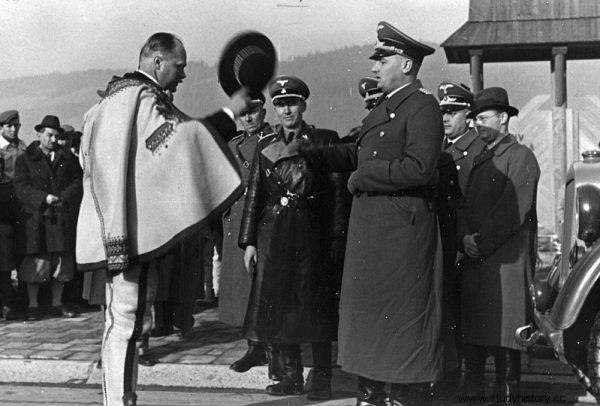
Wacław Krzeptowski, an influential leader and leader of a group advocating an alliance with the occupant, publicly thanked him for "liberating the Highlanders from the oppression of the Polish authorities"
In the case of the highlanders from Podhale, the Nazis did not have to make any special efforts to work out an "ideological cover" for an alliance with the people of the mountains, exotic in the Third Reich, living somewhere in occupied Poland, so in the land of "subhumans". The alleged scientific arguments, in fact being biased gibberish, were unfortunately suggested by the Poles themselves.
Already in September 1939, shortly after the Germans entered Poland, Dr. Henryk Szatkowski, a politician, social activist and Germanophile, began spreading the idea of Goralenvolk in Podhale. The second intelligent man behind Goralenvolk was one of the most mysterious figures in this history - a certain Witalijs Wieder, a former Polish Army officer who ran a guest house in Zakopane, who preached pro-German slogans in Podhale with great verve.
Today, some researchers believe that was recruited by the Abwehr before the war. It was he who organized a train trip to Jasna Góra for the highlanders before the "homage to Krakow". An allegedly noble religious purpose was a cover for a rapprochement with the occupant.
Guests from Giewont
"Arguments" to justify the German-highlander rapprochement, which the Germans knew very well and knew how to use, were found in the works of the Polish professor Włodzimierz Antoniewicz, more than 10 years older. years .
According to him, it was an echo of very ancient events dating back to the turn of antiquity and the Middle Ages, when, as a result of the invasion of the Asian barbarian Huns from the Asian steppes, the peoples of this part of Europe migrated to the West and South. Goths who had previously wandered through our country also fled. Some of them could hide from the Huns in the Tatra Mountains, and the rest of these events would be a "Gothic" stylist of Podhale decorations.
Such an observation constituted water for the mill of native traitors and the Nazis themselves. As vivid there is "evidence" of the common origin of the breed of gentlemen and highlanders from Zakopane and Nowy Targ . The elements referring to the Third Reich did not have to be looked for far. The shape of the swastika was found, for example, in the unexpected cross, popular in the mountains, carved over the doors of houses. The propaganda machine has gained momentum. The names of Tatra towns (Grywałd and Waksmund) were similar to the Old Germanic language, while the singing of the highlanders was compared to Alpine yodelling.
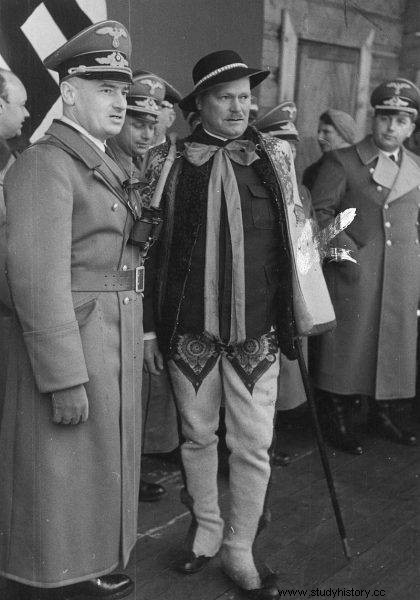
Governor Hans Frank (left) during a conversation with Wacław Krzeptowski (in a national costume)
Reaching back to the legendary ancient past to justify the quite real plunder of foreign lands and the exploitation of the peoples living there was nothing new in German politics. They explained the conquest of Poland and the exploitation of the Slavs by the fact that almost two thousand years ago, tribes considered Germanic lived in part of the country.
The hypothesis was also used, according to which the Slavs - Rus and the Polans - were to be founded by the Vikings . Nothing is that these are hypothetical events from a thousand years ago, not only questioned by many other researchers, but also having no bearing on the present day. They were perfect for propaganda purposes.
Goralenführer Krzeptowski and neues Highlanders Association (Goralenverein)
However, nothing happened without the cooperation of the locals. The self-proclaimed leader of Goralenvolk was announced by the most influential gazda Krzeptowski, a PSL politician before the war, rich, well-versed in salons and also flirting with the ruling camp, coming from one of the oldest families in Podhale.
Krzeptowski had neither education (he only finished 6 primary school years), nor - according to his contemporaries - he was not particularly brilliant. However, he was distinguished by stubbornness and great self-confidence. "(...) a buffoon who called himself» the prince of Podhale « , and whose feature was fanatical greed "- writes Wojciech Szatkowski about him.
Krzeptowski had a lot of debts on his account. The collaboration quickly paid off for him. He was already getting ready for a bailiff's visit, but as soon as he started working with a new ally, debt enforcement was suspended. The highlander "führer" must have realized that the success of the Goralenvolk project would depend on its further profits and career under the patronage of the Nazis.
Already at the end of November, with the consent of the Germans, he reactivated the pre-war Union of Highlanders, which from then on was to be called Goralenverein. The collaborator leader was successful. It turned out that the idea of cooperation with Hitler fell on fertile ground in Podhale . The Highlanders' Union accepted a new formula of operation under the German aegis - that is, the promotion of Germanic culture through, inter alia, establishing schools and sports clubs.
At the meeting, a faithful appeal to Hans Frank was read out, asking for help in fostering "Goralenvolk's national identity" and for granting economic privileges to the gazettes.
Neue Volk, neue Schule
The beginnings of Goralenvolk under Krzeptowski seemed promising. Subsequent initiatives were to familiarize the highlanders with the "national" idea and the alliance with the occupant. Already in the spring of 1940, a highlander primary school (Goralische Volksschule) was opened, where people were taught in the highlander and German languages. About 16% of children from Zakopane attended it.
A vocational school (Goralische Berufschule für Volkskunst) and a sports club (Goralische Heimatsdienst) were also launched. The attempt to open a German school ended in a complete failure - there were no applicants.
Krzeptowski and other leaders of the "highlander nation" realized that, contrary to appearances, the masses of highlanders remained indifferent, and often even hostile to the cause. There was also no spectacular success that could prove the legitimacy of Goralenvolk against the Nazis.
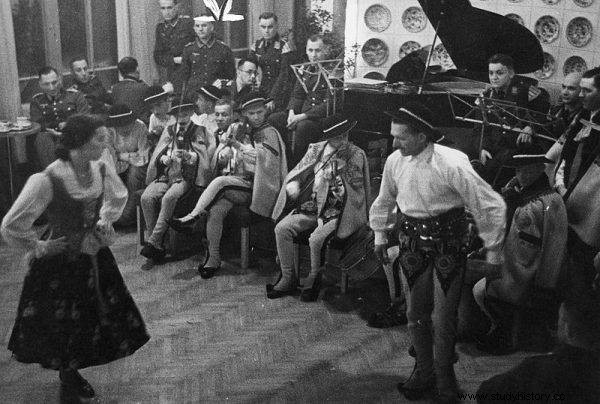
Highlanders' dance performance for German soldiers
The union intended to prove itself to the occupant by the census, which was carried out in June 1940 in the Nowy Targ poviat, and which at the same time - thanks to intrusive propaganda, persuasion and manipulations - was to confirm that the Tatra highlanders do not feel like Poles, but members of the Goralenvolk. Apart from nationalities such as Polish, German and Ukrainian, the participants of the census could also choose the highlander option. In fact, although Krzeptowski and his men traveled from village to village, persuaded and even threatened, the success of the census was moderate.
It is estimated that the "highlander" option was chosen by about 18% of the population. The rest declared their Polishness. It is true that there were places where over 90% of those questioned were in favor of the highlander nationality - e.g. in Szczawnica - but it resulted, among others, from from the fact that many older highlanders chose this answer, feeling that they were highlanders, with no opposition to Polishness. There were also those who added "Pole" to the slogan "Góral". Such votes were counted as the choice of "Goralenvolk", although that was not the intention of the participants.
On the other hand, the results of the census in Nowy Targ (17% of Goralenvolk declarations) or in Zakopane (23%) were particularly poor, i.e. where the new highlanders' association was most active. Krzeptowski and his helpers suffered a severe defeat in their own lair. Nevertheless, they continued to work actively for the highlander-German alliance.
Goralisches Komitee
In 1942, Highlander Committee (Goralisches Komitee) was established, which was to create the foundations for the future administration and self-government of the "highlander nation". Ultimately, the future Goralenland government was to come from the committee chaired by Krzeptowski, for now, he was to be responsible for contacts with the Reich and the General Government, cultural policy and education. Its seat was at 2 Bahnhofstrasse (now Kościuszki Street). Wojciech Szatkowski writes:
A pillow collection for wounded German soldiers was also organized, and highlander women mending worn uniforms and clothing of Wehrmacht soldiers. (…) A representative of this organization resided in the Ministry of Propaganda of the Third Reich in Berlin. Initially, it was F. Kolasiński, and then Andrzej Bachleda-Curuś.
Soon after, the committee carried out the action of handing out Kennkarte (ie occupation "identity cards"). Despite threats and encouragement to sign the volkslist, out of 150,000 kenkarts issued only 30,000 were blue (population of Germanic origin - this is how Highlanders were classified, next to e.g. Ukrainians) and the letter G.
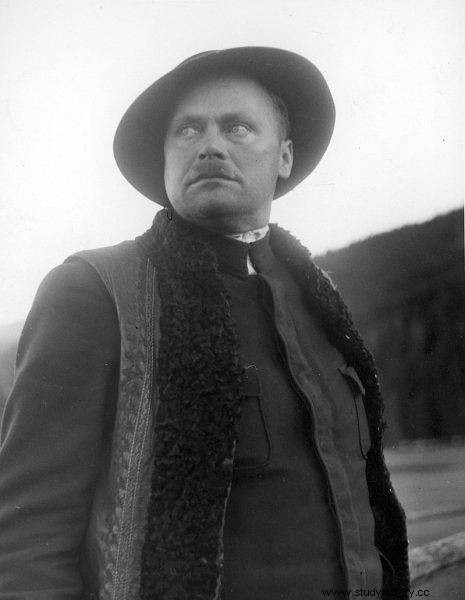
Krzeptowski had neither education (he only finished 6 primary school years), nor - according to his contemporaries - he was not particularly brilliant.
Goralenvolk leaders have been disappointed. The idea of pulling the highlanders away from Polishness did not captivate the masses. Nevertheless, the number of Volksdeutsche in the Tatras turned out to be the largest in the entire General Government.
Goralische Freiwilligen Waffen SS Legion
With the mounting difficulties in the east, the Germans paid less and less attention to issues such as Goralenvolk. At the same time, their needs grew. There were no recruits, so the occupation authorities asked the Highlander Committee to create an SS legion (Goralische Freiwilligen SS Legion). This was to be the final confirmation of the usefulness of Goralenvolk.
Ultimately, the legion was to consist of 10,000 soldiers. In January 1943, about 300 volunteers came to the hotel "Morskie Oko" in Zakopane. About 200 qualified for the training. They were put on a train that was supposed to take the recruits to the SS training camp in Trawniki in the Lublin region. Eventually, a dozen or so people reached him, the rest deserted . The alleged volunteers were to say later that they did not quite realize what they were signing up for. Some representatives of the highlander administration were supposed to drink vodka.
Oh, cord…
The failure to establish a highlander SS unit finally compromised the self-proclaimed highlander authorities and made the Germans aware of the uselessness of the Goralenvolk project. It turned out that, contrary to the zealous tales of people like Krzeptowski, people from the Tatra Mountains do not embrace the Nazis at all . There was no time for that anyway. The crowd was declining, and the Goralenvolk collapsed with it.
Its leaders realized that they had no support either in the occupant with whom they lost their credibility, or in the highlander community. What's more - they knew that the Polish resistance movement was waiting for them.
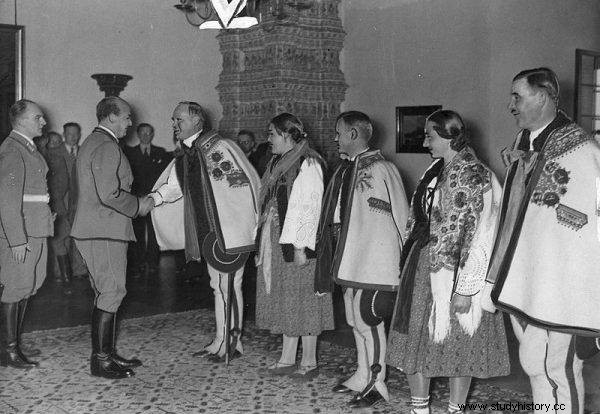
The failure of establishing the highlander SS unit ultimately compromised the self-proclaimed highlander authorities and made the Germans aware of the uselessness of the Goralenvolk project.
The Tatra Confederation, which was already broken (not without the participation of informers) in 1942, had the main goal of eliminating Krzeptowski and other traitors from Goralenvolk. In the end, the soldiers of the Home Army succeeded.
Krzeptowski, the prince of Podhale and goralenführer, hid in the mountains from 1944. In January 1945, he was tracked down by the Home Army unit of Lieutenant Tadeusz Studzieński "Kurzawa". Apparently, he begged for death by a bullet, but heard that he did not deserve it. It hung on a tree branch by the road near Nędzówka, where it was stopped by partisans.
Highlander, don't you feel sorry for ...
Immediately after the war, the remaining Goralenvolk leaders were sentenced to prison in the Zakopane show trials. Interestingly, his ideologues, Henryk Szatkowski and Witalis Wieder, avoided responsibility. They disappeared after the war, probably they evacuated from Podhale together with the Wehrmacht.
Such was the pitiful end of Goralenvolk - one of the most embarrassing pages in the history of Podhale and the history of Poland in general.
Collaboration with the enemy, which was stained by the black sheep and some highlanders, should not, however, obscure the fact that the vast majority of them did not deny their Polishness. There were also many heroes in Podhale who fought the invader with courage and dedication.
It is enough to mention the Tatra couriers, thanks to whom the correspondence of the Polish Underground State, as well as soldiers to the forming units, were sent through the difficult mountain routes to the south, and from there further to the West. In the other direction, weapons, money, underground press, emissaries and military instructors were smuggled. To this day, the memory of those people who kept the occupied country in touch with the rest of the fighting Europe is cultivated in Podhale.
